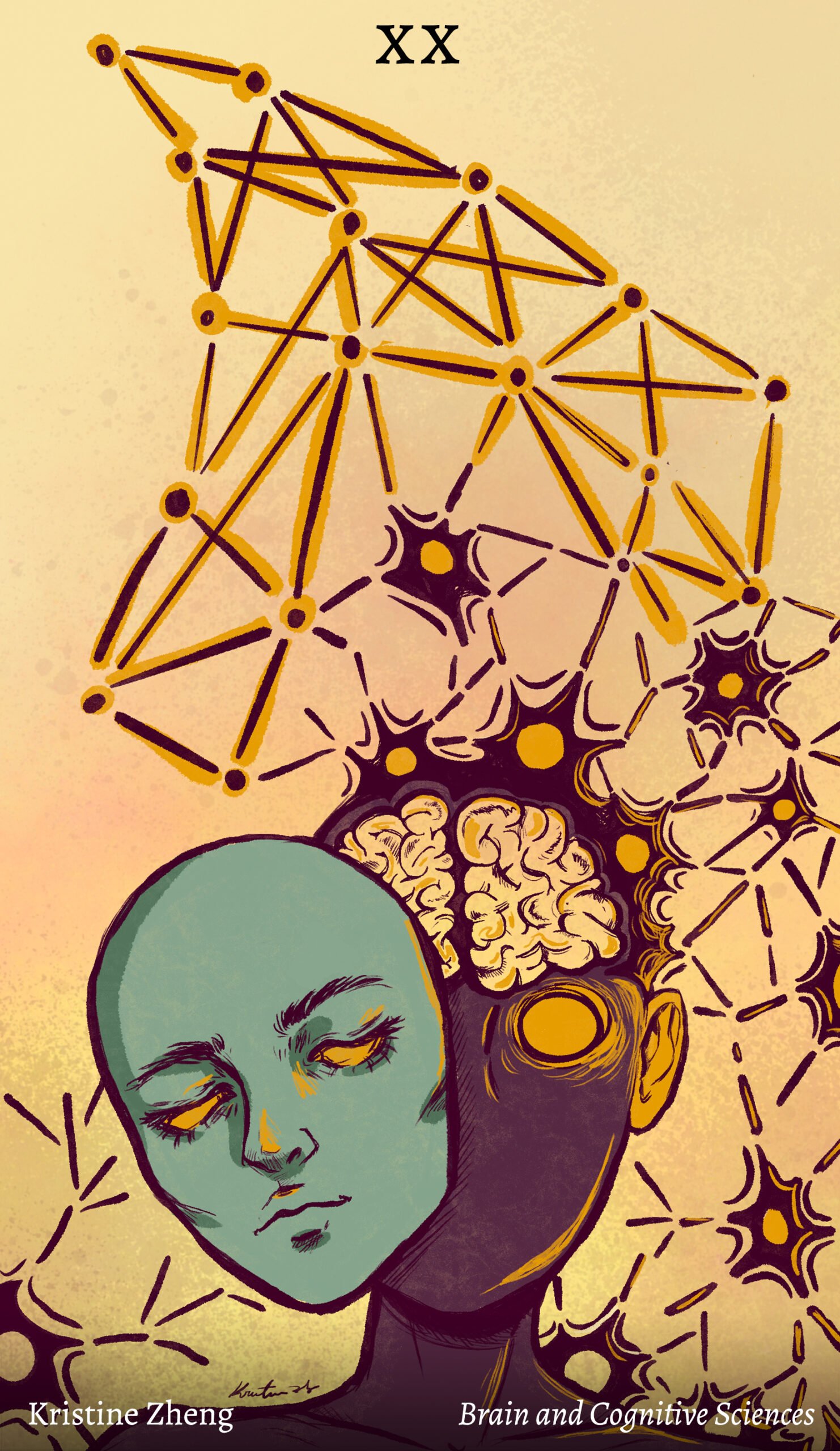
The MIT Major Arcana by CJ Q. '23
a collaborative art project
Each undergrad in MIT majors in one of 2101 The numbers skip 13, 19, and 23. The registrar lists CMS as XXI-CMS, and STS has no primary majors as of now. numbered courses, from 1: Civil and Environmental Engineering to 24: Linguistics and Philosophy. There is significance behind 21 majors, as 21 is also the number of major arcana in the Rider–Waite Tarot. Further, the arcana begins with 0: The Fool, which is not a part of the major arcana, in the same way that an undergrad begins with no major, being Undeclared.
This is not a coincidence because nothing is ever a coincidence.02 Catchphrase from <a href="https://unsongbook.com/">Unsong</a>, sometimes shortened to TINACBNIEAC by fans. Okay, it’s kind of a coincidence; if you’ve read my course catalog history you’d know that MIT had more than 21 numbered courses as recently as the 1990s. Anyway, I noticed this a few months ago, made a Twitter thread about some correspondences, and got the idea that I should commission art for this!
It was my first time commissioning art from people, and I had the following principles:
- I wanted to compensate artists for their time. I had no idea what a fair price was, so I offered $20 per card, and it seemed that people were fine with that? This money came out-of-pocket; I’m not making any money off this, I just wanted to see this happen.
- I didn’t want to use generative AI or whatever. Even more strongly, I wanted each card to be by an MIT student, and as much as possible get a different artist for each card. That means coordinating between 22 people, which wouldn’t be too hard, right?
- Not only did I want a different artist for each card, I wanted the cards to be as different from each other as possible too. That meant not having a consistent style between cards, and embracing the many different art styles that artists had. That meant I didn’t have tight specifications for each card either. I constrained the size and borders, and that’s it.
Some lessons I learned:
- I wrote a spec doc with some details that I gave to artists. This turned out to be a great idea, though I could’ve made some details clearer, like payment methods, or that I wanted artist’s notes for each card.
- Different artists take different amounts of time to make art. Some artists finish overnight, others take a few weeks of incremental progress. I forgot to account for this when scheduling things.
- Sometimes things happen to people, and they can’t finish what they signed up to do. It’s not that that person is bad, it’s just life. This is also something I forgot to account for when scheduling things.
- That adage about multiplying time estimates by π is true. Even when you think you’ve accounted for the buffer time, you haven’t, and you always need to have more buffer. Always. Hence why I’m making this post several months after I graduated…
Anyway, here’s the cards!
0: The Fool / 0: Undeclared
The Fool represents beginnings and spontaneity, and is set apart from the Major Arcana by being unnumbered. A first-year student begins MIT undeclared, ready to embrace the unfamiliar.
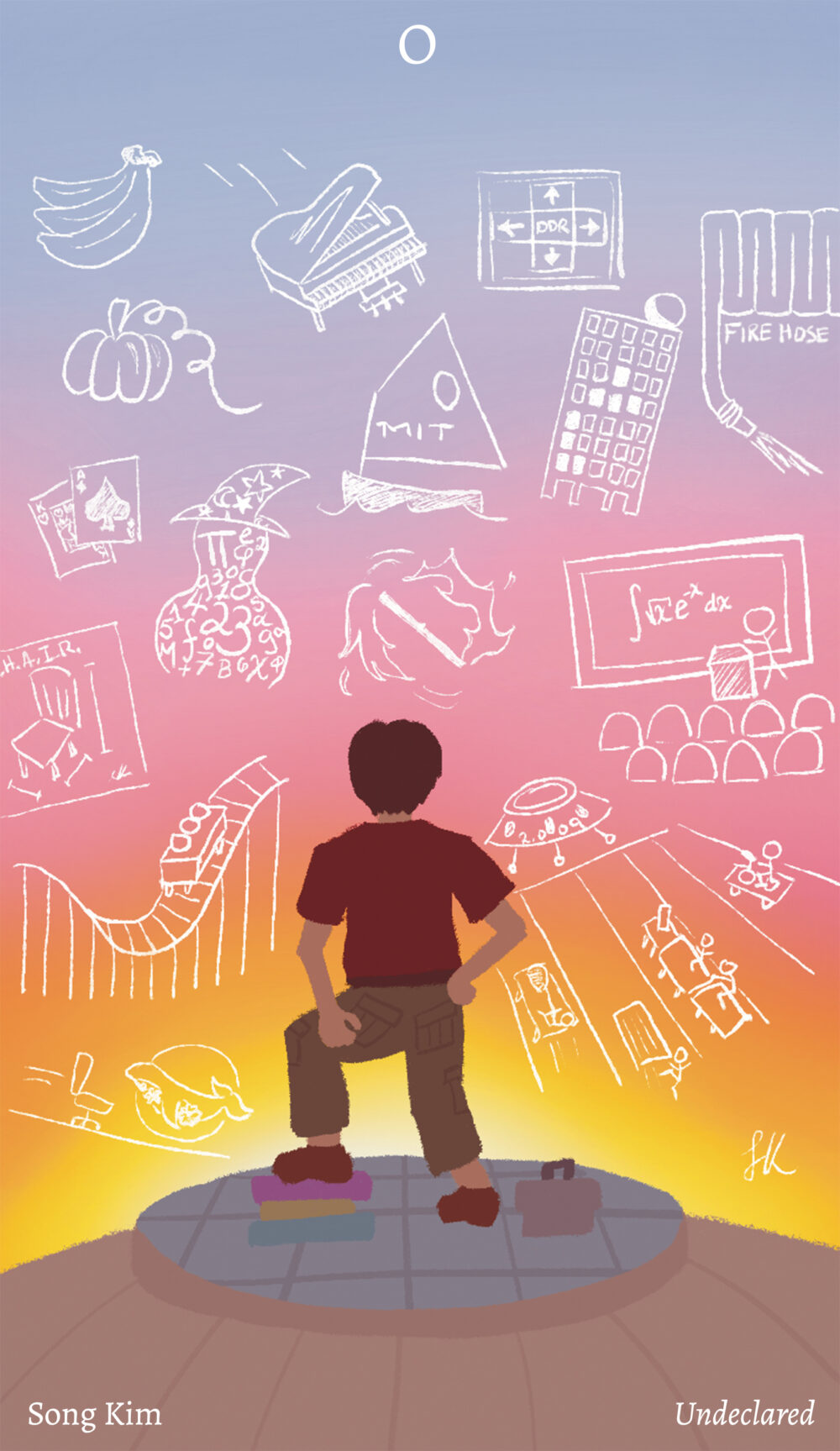 Artist: Song K. ’25, major in Computer Science and Engineering.
Artist: Song K. ’25, major in Computer Science and Engineering.
The Fool traditionally stands precariously at the edge of a cliff. We don’t really have cliffs on campus, but this frosh is standing on top of the Great Dome. (don’t try this at home) They are also in approximately the same pose as the person in Wanderer above the Sea of Fog.
I: The Magician / 3: Materials Science and Engineering
The Magician taps the forces of the universe to create things, a conduit between the spiritual and the physical. In MIT’s Glass Lab and Metal Lab, people bend material objects according to their will, shaping reality to match their thoughts.
 Artist: Rihn ’23, major in Mechanical Engineering, major in Humanities and Science, @rihnscape on Instagram.
Artist: Rihn ’23, major in Mechanical Engineering, major in Humanities and Science, @rihnscape on Instagram.
The magician; blowing a witch’s ball out of glass. Using tweezers, they manipulate glowing molten glass at the end of a blowpipe into a delicate ornament. The scene is framed with ornate wrought iron swirls. This card’s content is based off the MIT glass lab and the forge and foundry in the basement of the infinite. The likeness of the magician is loosely inspired by several of the glass lab’s wicked cool instructors.
II: The High Priestess / 24: Linguistics and Philosophy
The High Priestess guards the inner structures of our thoughts, the objects that philosophers study. The card also represents the mystery of infinite potential. How can a finite language contain infinite utterances?
 Artist: Shuli J. ’22, major in Computer Science and Engineering.
Artist: Shuli J. ’22, major in Computer Science and Engineering.
The High Priestess sits at a desk, contemplating a complex syntax tree. To her left and right are alternate universes where similar but different versions of herself do the same thing. Each of them hangs in the space of infinite possibility and branching. In the physical space below them, galaxies form; in the abstract space above them, linguistics symbols tumble around.
III: The Empress / 7: Biology
The Empress is seated in the realm of nature, the setting for the life sciences. Through molecular biology and genetics, researchers seek ways to treat diseases and promote health. Nurturing and sustaining, two key characteristics of The Empress.
 Artist: Michaela P. ’24, major in Biology.
Artist: Michaela P. ’24, major in Biology.
I don’t really have much of an artist’s statement. I just liked drawing this.
IV: The Emperor / 8: Physics
The Emperor is about rules and structure. Things like dark matter, ultracold gases, or high-temperature superconductors all show that complex structure can arise from simple physical rules.
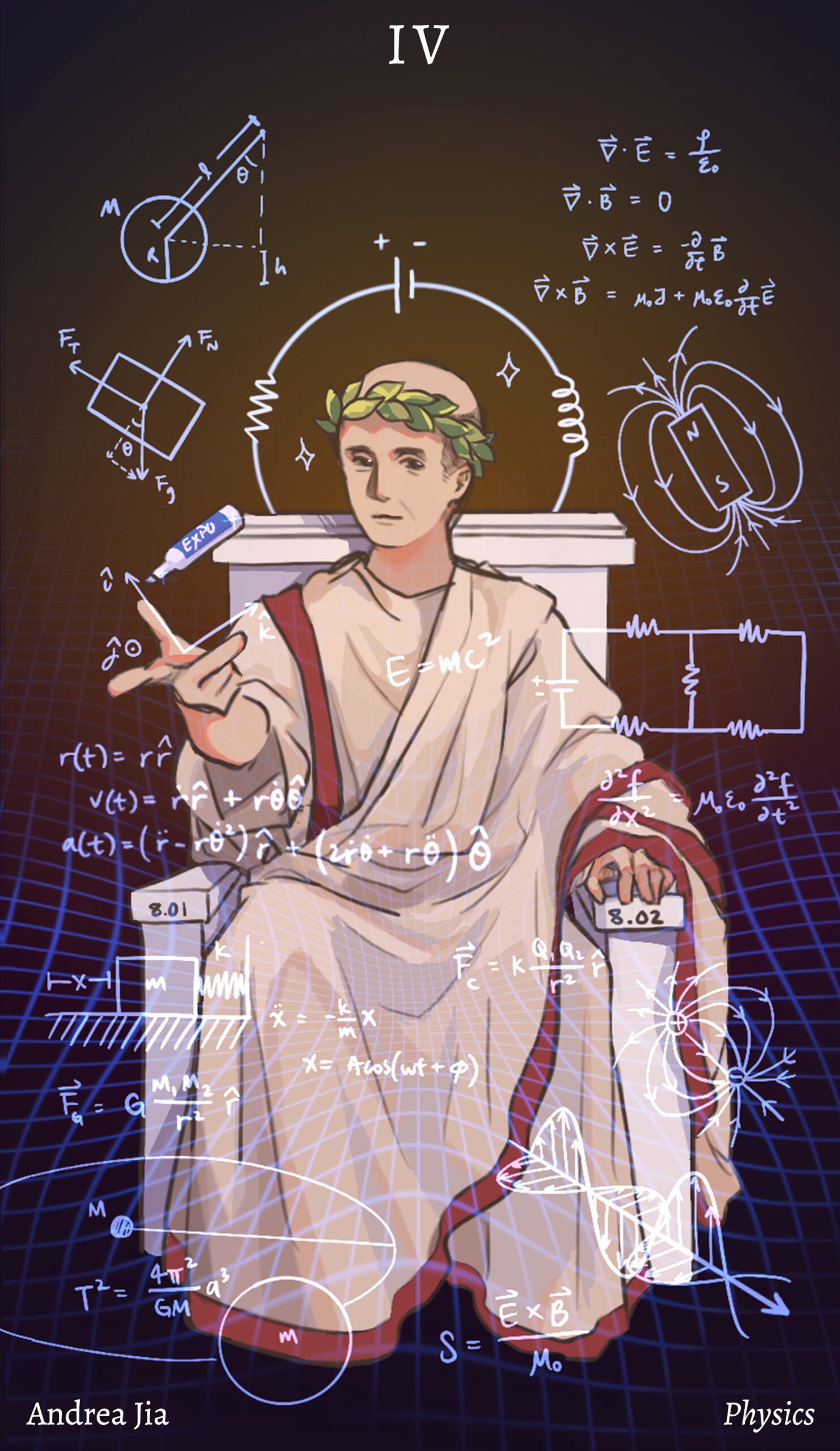 Artist: Andrea J. ’26, major in Computation and Cognition, @hydreajia on Instagram.
Artist: Andrea J. ’26, major in Computation and Cognition, @hydreajia on Instagram.
With physics as a graduation requirement, all undergraduates have some sort of interaction with the MIT physics department. Most students take 8.01 and 8.02 to fulfill the physics requirement. These subjects are taught in a unique flipped classroom format using lightboard videos. 8.01 and 8.02 are shown on the pillars of the emperor’s throne to represent their foundational nature, and the lightboard is incorporated with glowy writing all across the card. The emperor levitates a marker using the power of the right-hand rule. The emperor is dressed in robes that resemble Roman attire to give a scholarly look, and his features take inspiration from Peter Dourmashkin, one of the beloved staff of 8.01 and 8.02 who is a prominent lightboard video instructor. Finally, I’d like to credit my friend Lucas Ospina ’26 on the card as he helped me come up with many of the ideas that make the card what it is :)
V: The Hierophant / 18: Mathematics
The Hierophant represents formal systems and the pursuit of knowledge. The rigor and axioms that form the basis of modern mathematics form the dogma of mathematical belief, and many mathematicians find math intrinsically worthy of pursuit.
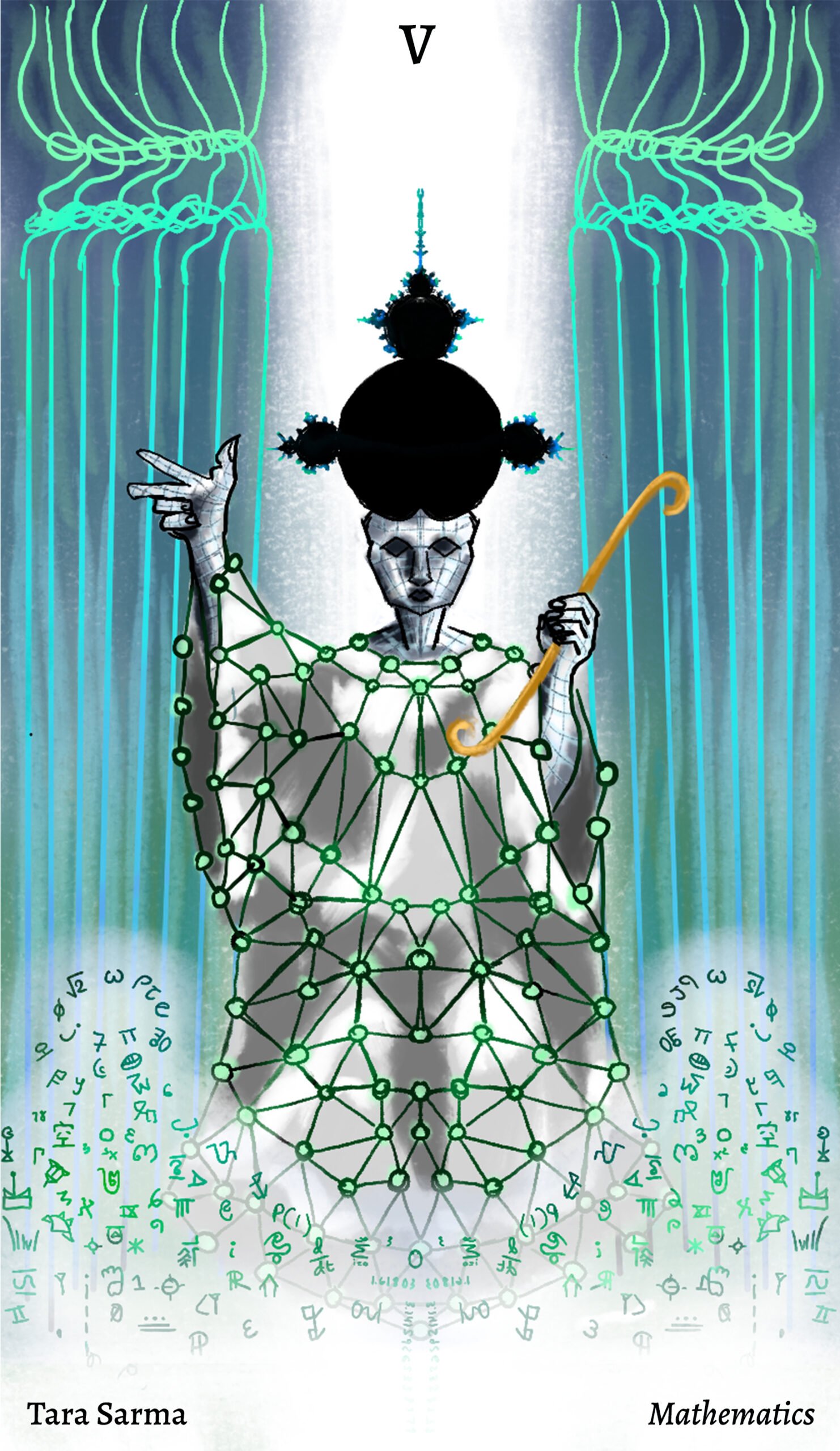 Artist: Tara S. ’24, major in Computation and Cognition.
Artist: Tara S. ’24, major in Computation and Cognition.
I basically tried to convert all of the typical elements of the hierophant card into math concepts. The two pillars are now knotted strings meant to be a nod to knot theory in topology. The hierophant’s crown in the Mandelbrot set fractal. Their robe are is meant to look like an undirected graph. Their right hand is showing the right hand rule used for cross products, and their left hand holds a golden integral sign. The two devotees are made of various numerical notations from different time periods and cultures. I tried to generally have a chronological ordering to it, starting from a copy of tallies from Ishango bone, one of the earliest known numerical-related inscriptions, and continuing outwards.
VI: The Lovers / 21: Humanities
The Lovers is about relationships, values, and chocies. These are explored under the many departments of the School of Humanities, Arts, and Social Sciences, ranging from anthropology to music to history to gender studies.
 Artist: Dora H. ’25, major in Computer Science and Engineering.
Artist: Dora H. ’25, major in Computer Science and Engineering.
The Lovers represents relationships and choices; Course 21 covers a broad range of fields that intersect with each other and fall under the umbrella of MIT’s HASS requirement. The lovers are discussing their differing opinions on the person in the middle’s newest artistic creation while studying/working on individual projects in various humanities fields. I put references to Course 21- and HASS-related classes and activities in the lovers’ assignments, as well as the bulletin board behind them (i.e. the orange textbook on the table is Genki, the textbook used by MIT’s Japanese classes). I included three people to reference the abbreviation “HASS” (H, A, S). Here’s a game: count the hearts in the drawing!
VII: The Chariot / 2: Mechanical Engineering
The Chariot represents the willpower necessary for an undergrad to study mechanical engineering in MIT, like the willpower required to take a class and present your work to thousands of people.
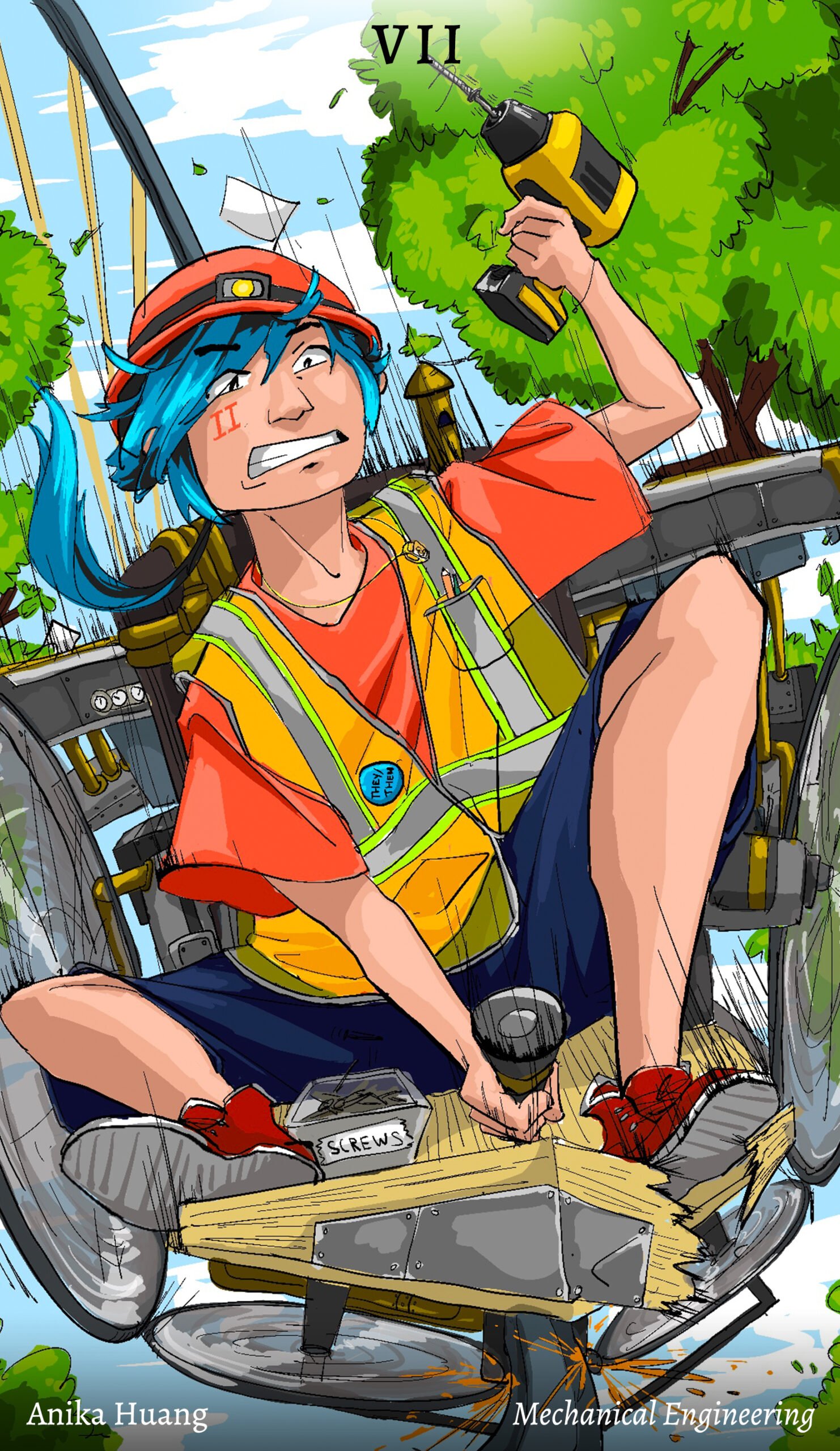 Artist: Anika H. ’26, major in Electrical Engineering and Computer Science.
Artist: Anika H. ’26, major in Electrical Engineering and Computer Science.
(anika didn’t write an author’s note, so this is cj pretending to be anika writing one) rollercoaster go brrr
VIII: Strength / 15: Management
Strength encompasses patience, tolerance, and compassion, person-oriented skills that go a long way in the world of business. The management major doesn’t need force or coercion to tame their problems.
 Artist: Teresa J. ’26, major in Business Management and Design, @pianofinqers on Instagram.
Artist: Teresa J. ’26, major in Business Management and Design, @pianofinqers on Instagram.
The overall layout of the card is heavily based on other Strength tarot card designs, which traditionally feature a woman taming a lion with an infinity symbol on/above her head. I replaced the white robes you’d typically see with a business suit, and kept with the white, gray, and red color palette I normally associate with MIT. I gave her the infamous course 15 backpack, as well as a brass rat as little nods to everyday MIT apparel. As for the symbols in the back, I just put some that are commonly linked with business majors: email, briefcases, bar charts, even a playing card inspired by 15.0251, a game theory class I took on listener. I especially made sure to add a nametag with the name Sloan on it, as name placards are required in most business classes, as well as a little calender with 15 as the date as an homage to business being course 15.
IX: The Hermit / 10: Chemical Engineering
The Hermit gives up outside distractions to focus on their work. Chemical engineering undergrads have nicknamed their course lounge “The Bunker”, symbolic of their dedication to comprehensive major requirements.
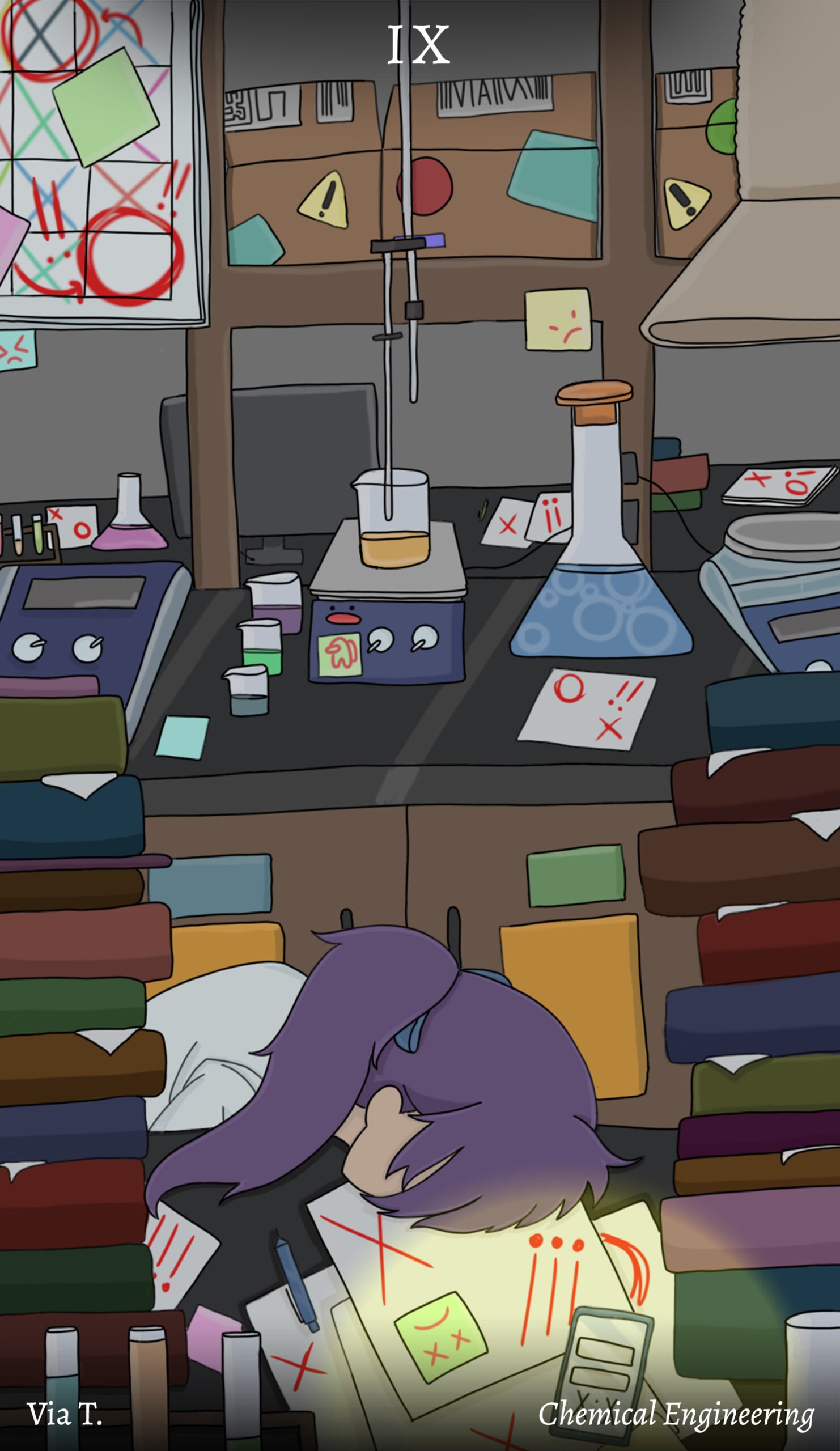 Artist: Via T. ’26, major in Computer Science and Engineering.
Artist: Via T. ’26, major in Computer Science and Engineering.
MIT is hard. Often times, we find ourselves holed up in labs or libraries, trying to meet deadlines for thesis, projects, and psets. It’s hard not to feel alone during these times, as we miss calls and texts from those we care about because we just don’t have time. For this tarot card, I attempted to recreate these times, depicting a student asleep in lab, trying to make deadlines while their friends try to reach them. The equally scribbled papers on the other work stations remind us that despite the fact we are struggling alone at the moment, others are also in the same boat.
X: Wheel of Fortune / 14: Economics
The Wheel of Fortune, on the surface, is about luck, but it’s also a vision of the world’s systems working in harmony. Economists cut through seemingly random data, looking to create policy and programming that’ll make the world better.
 Artist: Elizabeth W. ’26, major in Mathematical Economics.
Artist: Elizabeth W. ’26, major in Mathematical Economics.
Most of the card is based on the Stonks internet meme, with the Alchemist as the guy in the meme. The wheel and the moons surrounding the wheel are representations of the actual wheel of fortune, as well as the money sticking out of parts of the wheel. The firehose was just included to reference MIT, and the numbers of the stocks in the background are course 14 class numbers, such as 14.01, 14.02, etc.
XI: Justice / 11: Urban Studies and Planning
Justice and fairness across services like housing and transportation is a key urban planning goal. Crucial to achieving this is a deep understanding of cause and effect, another aspect of Justice.
 Artist: Caroline C. ’25, major in Urban Science and Planning with Computer Science.
Artist: Caroline C. ’25, major in Urban Science and Planning with Computer Science.
The scales of justice are unbalanced. The central figure Justice represents the honorable late Mel King who, along with many hands from the community, is poised to add more housing to rebalance the scales (thanks to anon for suggesting this). The map of the Cambridge/Boston area emphasizes a sense of place.
XII: The Hanged Man / 1: Civil and Environmental Engineering
The Hanged Man looks defeated or lost, but finds success by acknowledging his situation. The climate crisis can be discouraging, but civil and environmental engineers are committed to respond.
 Artist: Jinhee W. ’26, major in Management.
Artist: Jinhee W. ’26, major in Management.
i based it around ecobrutalism (the meaning behind the hanged man, as a symbol of rebirth and renewal in a sense), as well as incorporating small elements such as a bridge in the water and small windmills in the windows. for references to the hanged man, it was mainly just having her hang from a tree
XIII: Death / 5: Chemistry
Death is about inexorable change and shedding the superficial, much like the difference between the chemical and the merely physical. Death represents transformation, and from chemistry we get a key example: chemical reactions. Artist: Madison W. ’25, major in Chemistry.
Artist: Madison W. ’25, major in Chemistry.
In order to design the card, I drew upon ideas of Eastern spirituality, where life and death are deeply intertwined. The lotuses represent rebirth and enlightenment, but the number four, which is the amount that are blooming, represents death. I also opted to tranform the periodic table, an emblemic symbol of chemistry, from its traditional form to a circular format, attempting to conjure the image of the samsara and alchemy circles. The imagery hopefully evokes a more gentle and empathetic interpretation of the card.
XIV: Temperance / 20: Biological Engineering
Temperance is about balance and health, factors that come into play when engineering biology to benefit humanity. Patience and purpose are key to both Temperance and wet lab work.
Artist: Marissa A. ’23, major in Biological Engineering.
I kind of wanted the vibe of a less-is-more tarot card deck. The angel of temperance has been replaced by a bioengineer and her chalices are now a pipette and microcentrifuge tube. The background, though some of it obscured by the scientist, contains references to all course 20 core classes. And, as a small easter egg, representing the depicted polypeptide as its one letter codes spells out TEMPERANCE on repeat.
XV: The Devil / 6: Electrical Engineering and Computer Science
The Devil represents material wealth, addiction, and ignorance. Do any of us fully understand the consequences of the technologies we wrought upon the world?
Artist: Michelle M. ’26, major in Computer Science and Engineering
the card is from the pov of a course 6 student reaching towards the alluring glow of their laptop, a portal to infinite power and knowledge but also deep danger. we see the figure of a student whose shadow morphs into a demonic figure (the bezos head shape was not intentional but we can pretend it was) with a twisted devils horn crown (it’s the citadel logo.) there are eyes in the background as well as the webcam as a symbol of the perpetually watchful eyes of the internet and judgement as a whole. i also made the eyes kinda distorted and the ai-generated-esque hands very distorted as a symbol of recent advances in ai and the ethical questions that arise with them, esp in the realm of art. (to be honest idk why i chose to draw eyes and hands. the bane of my existence smh </33). oh also the webcam eye is red as a portrait of the average eecs student (coming into mit i saw that one compilation of student sleep times by major and saw eecs averaged around 3 am, and thought “??? no way that’s me”,,, oops lmao) also the background is red bc i thought it looked cool. no blue curtains there
XVI: The Tower / 4: Architecture
The Tower is hit by fire and lightning, and yet it stands. An architect designs a building with physical disasters and other challenges in mind.
Artist: Jenny B. ’25, major in Artificial Intelligence and Decision Making.
I had fun squeezing in references to real-world architecture in and around campus. The obvious references are the Great Dome and the little roller coaster-esque rendition of the MBTA Red Line. But if you look closely to the sides of the Great Dome, I stuffed in Simmons Hall (left) and Stata Center (right), since they’re pretty recognizable on-campus. I also added the Wiesner Building (MIT Media Lab, List Visual Arts Center) which was designed by I.M. Pei. At the very top of the tower, I stuck some vague renditions of brutalist architecture, kind of to poke fun at the Student Center and also Boston’s City Hall and Government Service Center. Everything else is made up.
XVII: The Star / 22: Nuclear Science and Engineering
The Star shines with hope for the future, representing faith in response to difficulties. Nuclear science shines with the promise of clean energy, undaunted by the grand challenge of fusion.
Arist: Emily L. ’24, major in Computer Science and Engineering.
Didn’t really have an artist’s note to add, just combined the star arcana traits with elements of course 22 and also puffin
XVIII: The Moon / 16: Aeronautics and Astronautics
The Moon is the triumph of imagination over fear and uncertainty. Boundless imagination flew us to the moon despite fears of falling, despite imperfect tools and instruments.
Artist: Steven L. ’23, major in Aerospace Engineering.
Most of the layout and design is just what i think looks nice, but the wolf and the space shuttle name Divination are references, respectively, to typical designs for the Moon arcana in tarot decks and tarot’s perhaps most notorious use. The wolf tail becoming the Milky Way is an arbitrary choice; similarities to some Native American myths are purely coincidental.
XIX: The Sun / 12: Earth, Atmospheric, and Planetary Sciences
The Sun drives the Earth’s weather and climate. The undergrad EAPS motto encourages students to go beyond, and bring discovery energy into their fieldwork, attributes The Sun reminds us to hold.
Artist: Gloria Z. ’26, major in Mechanical Engineering, @orangebead_ on Instagram.
For my card, I incorporated imagery corresponding to the fields of study in EAPS: the ocean for earth, wind and clouds for atmosphere, and the sun for planetary bodies! I tried to imitate traditional tarot styles when drawing the sun, human figure, and telescope. The waves and seafoam at the bottom are inspired by Hokusai’s famous print “The Great Wave off Kanagawa” :).
XX: Judgement / 9: Brain and Cognitive Sciences
Judgement is about discernment and reckoning, examples of cognition. BCS seeks to understand our mind, which all judgement ultimately comes from.
Artist: Kristine Z. ’24, major in Computation and Cognition.
Like the various directions of BCS, this scene includes perception through the senses, understanding in the mind, neurons to neuron connections, and corresponding neural network models. The neural network shape literally and visually represents the trumpet call in the Judgement card which brings everything hiding under the mask into the open like how the models strive to uncover mysteries of the brain.
XXI: The World / 17: Political Science
The World represents completion, integration, and involvement in society at large. Political science focuses on global understanding, and seeks to empower individuals to participate in governance.
Artist: Rachel P. ’24, major in Management.
Political science represents the study of governments and political behavior, even at an international level. The red pins and string on the earth represents the interconnectedness of the different states of the world.
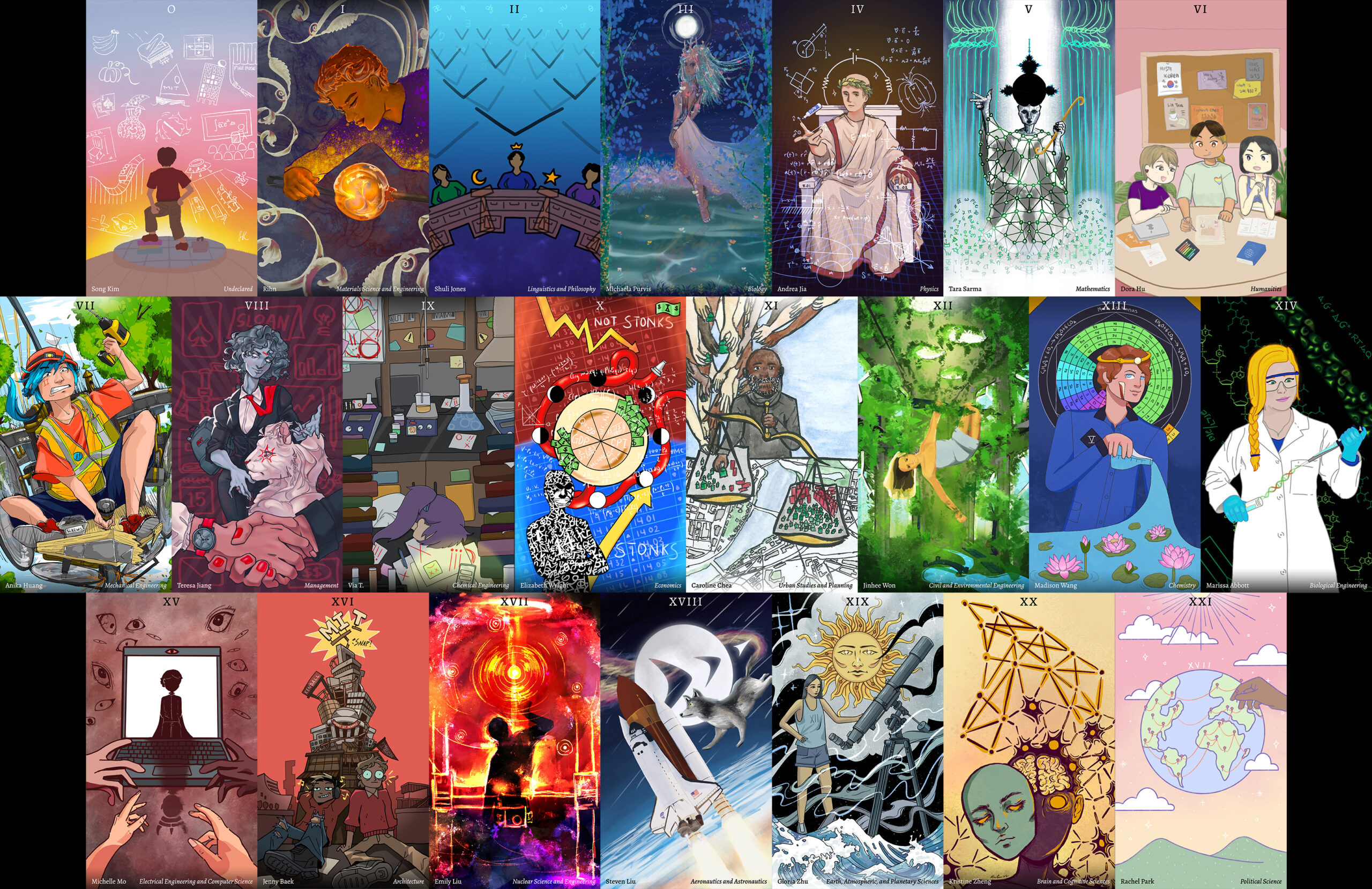 Final thoughts
Final thoughts
I don’t have plans to organize a print run, though I do want a physical copy. If you’re interested in printing these, hit me up and we can talk about it.
For me, this project was a reminder that things happen because people make them happen. I thought getting people to make art would be cool, so I wrote a spec doc, asked friends for feedback, wrote an email, and set up a spreadsheet. I’m super happy with how the project went, and it’s satisfying to see this finished after several months of coordinating between people.
- The numbers skip 13, 19, and 23. The registrar lists CMS as XXI-CMS, and STS has no primary majors as of now. back to text ↑
- Catchphrase from Unsong, sometimes shortened to TINACBNIEAC by fans. back to text ↑






